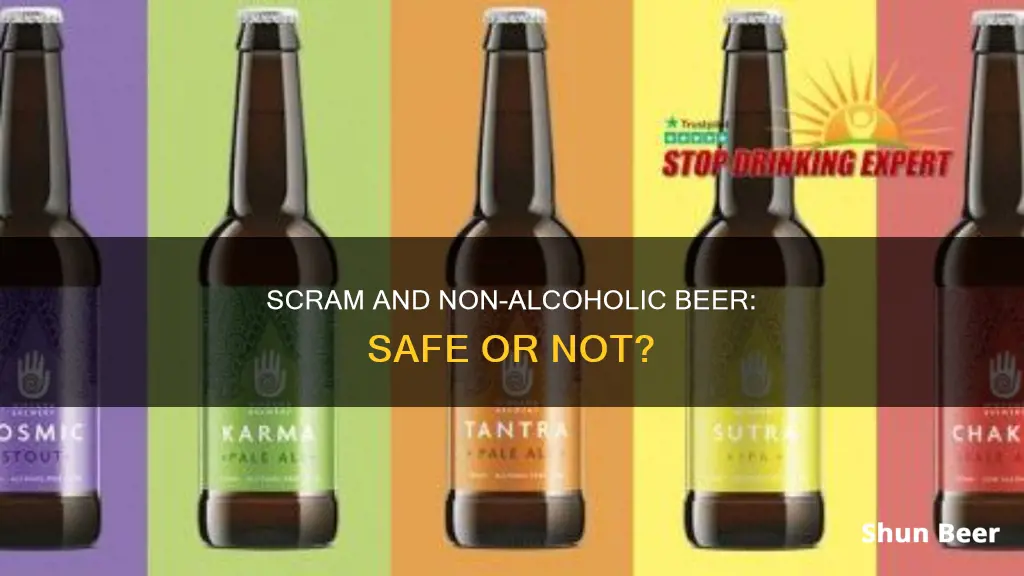
Drinking non-alcoholic beer while wearing a Secure Continuous Remote Alcohol Monitoring (SCRAM) bracelet is not recommended, as it may lead to a positive alcohol test result. While non-alcoholic beer is technically allowed, many non-alcoholic beers still contain a small amount of alcohol, and the fermentation process can leave traces of alcohol in the final product. SCRAM bracelets are highly sensitive and can detect even low levels of alcohol consumption. Therefore, consuming multiple non-alcoholic beers or drinking them in quick succession could lead to a positive test result. Additionally, there is a risk of inaccurate labelling of non-alcoholic beers, with some beverages claiming to have no alcohol found to contain over 1% alcohol. As such, it is advisable to avoid drinking non-alcoholic beer while wearing a SCRAM bracelet to reduce the risk of violating the terms of your monitoring program.
| Characteristics | Values |
|---|---|
| What is a SCRAM bracelet? | A Secure Continuous Remote Alcohol Monitoring bracelet. A non-invasive monitor that transdermally detects alcohol in the system. |
| How does it work? | It detects alcohol vapours by creating an electrical current in the SCRAM proportional to the amount of alcohol present in the sampled air. |
| Who might have to wear one? | Those in sobriety programs, community corrections, celebrities, domestic violence, DWI, and specialty courts. |
| How sensitive is it? | It can detect a BAL of 0.02g/dL with a high hit rate. |
| Can it detect one beer? | Yes, 60% of participants had a positive SCRAM reading after 1 beer. |
| Can you trick it? | It is not recommended. Some have tried to prevent perspiration by putting their ankle in an ice bath, but this may not work and is not worth the risk. |
| Is non-alcoholic beer safe to drink while wearing a SCRAM bracelet? | Technically yes, but it depends on the product. Non-alcoholic beer can contain up to 0.5% alcohol, and some have been found to contain more than 1% ABV. |
| What is the risk with non-alcoholic beer? | Inaccurate labelling may result in a positive SCRAM test. |
| How can you minimise the risk? | Stick to 0.0% ABV beers. |
What You'll Learn
- Non-alcoholic beer may contain small amounts of alcohol
- SCRAM bracelets can detect very low levels of alcohol
- The consequences of drinking non-alcoholic beer while wearing a SCRAM bracelet
- The potential for false positives when wearing a SCRAM bracelet
- The impact of drinking non-alcoholic beer on SCRAM bracelet data

Non-alcoholic beer may contain small amounts of alcohol
Non-alcoholic beer is often presented as a safe alternative to alcoholic beer. However, it is important to be aware of the risks before consuming it, especially if you are pregnant, trying to become pregnant, or have a history of alcohol use problems.
Non-alcoholic beer is typically made by removing the alcohol from regular beer. This is usually done through filtration or heating, and carbonation and flavourings are then added. While this process removes most alcohol, small amounts may remain. By law, non-alcoholic beers can contain up to 0.5% alcohol by volume (ABV). However, products marketed as alcohol-free are required to contain 0.0% ABV, meaning there are no detectable levels of alcohol in the product.
Despite these regulations, research suggests that many non-alcoholic beers contain more alcohol than their labels indicate. A study found that 29% of no- or low-alcohol beers tested had higher alcohol levels than stated on the label. Of the zero-alcohol beers sampled, six were found to have alcohol levels higher than one per cent. This inaccuracy in labelling can pose a risk to those who must abstain from alcohol, including pregnant people and those with a history of alcohol use problems.
In addition, drinking non-alcoholic beer can cause some people to test positive for alcohol in their urine or breath. This is because, in certain rare instances, drinking non-alcoholic beer can sharply increase blood alcohol levels, especially in people with alcohol-related liver damage.
Therefore, it is important to be aware that non-alcoholic beer may contain small amounts of alcohol. While it can be a good option for people looking to reduce their alcohol intake, it should be avoided by those who need to completely abstain from alcohol.
Beer, Painkillers, and Autumn: A Safe Mix?
You may want to see also

SCRAM bracelets can detect very low levels of alcohol
SCRAM bracelets are highly sensitive and can detect even very low levels of alcohol consumption. The bracelets use transdermal analysis to sample and test the perspiration on the skin every 30 minutes. This means that even if an individual has consumed a small amount of alcohol, the SCRAM bracelet is likely to detect it.
The bracelets are so sensitive that they can detect a Blood Alcohol Concentration (BAC) of 0.02 or above. This is a very low level of alcohol consumption, and it only takes one or two drinks to reach this level. In fact, a study found that 60% of participants had a positive SCRAM reading after just one beer. This number increased to 95% and 100% after two and three beers, respectively.
Due to their sensitivity, SCRAM bracelets can detect alcohol consumption from non-alcoholic beers, which by definition can contain up to 0.5% alcohol. This is because ten non-alcoholic beers at 0.5% ABV are equivalent to one standard alcoholic drink. Therefore, consuming a significant number of non-alcoholic beers could lead to a positive SCRAM reading.
Furthermore, it is important to note that the labels on non-alcoholic beers may be inaccurate, and some may contain more alcohol than stated. For example, a Canadian study found that 29% of beverages claiming to be alcohol-free or low alcohol actually had higher levels than advertised. As a result, drinking non-alcoholic beer while wearing a SCRAM bracelet carries some risk.
However, some non-alcoholic beers are absolutely safe, with 0.0% alcohol content. Examples include Budweiser Zero and Sober Carpenter IPA. These drinks are unlikely to show up on a SCRAM bracelet due to their extremely low alcohol content.
In conclusion, while it is technically possible to drink non-alcoholic beer while wearing a SCRAM bracelet, it is important to exercise caution. Individuals should carefully read labels, be aware of varying state regulations, and consume non-alcoholic drinks in moderation to reduce the risk of a positive SCRAM reading.
Plato's Beer: The Science Behind It
You may want to see also

The consequences of drinking non-alcoholic beer while wearing a SCRAM bracelet
Drinking non-alcoholic beer while wearing a SCRAM bracelet is not recommended, as it could lead to unintended consequences. Here are some key points to consider:
Risk of Inaccurate Labelling: Non-alcoholic beers may still contain small amounts of alcohol, and their labels may not always be accurate. In some cases, non-alcoholic beers have been found to contain higher levels of alcohol than stated on the label. This could potentially trigger a positive reading on the SCRAM bracelet, even if the amount of alcohol consumed is well below the legal limit.
Varying Definitions of "Non-Alcoholic": It's important to note that the definition of "non-alcoholic" beer varies by region. While the FDA defines it as having less than 0.5% alcohol by volume (ABV), some states in the US allow up to 1% ABV. Consuming non-alcoholic beer in a state with higher limits could increase the risk of a positive SCRAM reading.
Sensitivity of SCRAM Bracelet: The SCRAM bracelet is highly sensitive and can detect extremely low levels of alcohol consumption. In studies, it has detected alcohol consumption in 60% of participants after just one beer. Therefore, even a small amount of alcohol in a non-alcoholic beer could potentially be detected.
Consequences of Positive Reading: If the SCRAM bracelet detects alcohol consumption, it could result in legal consequences, depending on the terms of the wearer's probation or court order. This may include sanctions such as increased monitoring, alcohol treatment, or even revocation of bond or probation.
Alternative Options: Instead of non-alcoholic beer, it is recommended to choose beverages that are guaranteed to be alcohol-free, such as Budweiser Zero or Sober Carpenter IPA. These options pose less risk of triggering a positive reading on the SCRAM bracelet.
In conclusion, while drinking non-alcoholic beer while wearing a SCRAM bracelet may be technically allowed, it carries certain risks and potential consequences. It is important for individuals to carefully consider these factors and make an informed decision based on their specific situation and requirements.
Old Beer: Safe to Drink or Not?
You may want to see also

The potential for false positives when wearing a SCRAM bracelet
The Secure Continuous Remote Alcohol Monitoring (SCRAM) bracelet is a device used to monitor an individual's alcohol consumption. It is often used as a condition of parole or probation, or as a way to avoid jail time. While the SCRAM bracelet is considered reliable by judges and probation officers, it is not perfect and false positives can occur.
False positives occur when the SCRAM bracelet incorrectly indicates that the wearer has consumed alcohol when they have not. This can happen in a few different ways. Firstly, non-alcoholic beers may contain small amounts of alcohol, and if consumed in large enough quantities, could trigger a positive reading on a SCRAM bracelet. Additionally, the labels on non-alcoholic beers may be inaccurate, with some beverages claiming to have no alcohol actually containing over 1%.
Another way false positives can occur is through exposure to products containing alcohol. Alcohol is present in many consumer goods such as hairspray, lotions, mouthwash, and even kombucha. While using these products near the SCRAM bracelet may not trigger a false positive, spending an extended period of time around these products, such as in a hair salon, could result in a false positive. It is important to note that the SCRAM bracelet does not distinguish between alcohol consumed and alcohol exposure, and it is up to the recipient of the data to analyze and interpret the results.
Furthermore, the technology used in the SCRAM bracelet is similar to that of handheld Preliminary Breath Tests used by police, which are known to be unreliable and inadmissible in court. This technology does not specify the reading to ethyl alcohol, the type of alcohol consumed in beverages, but rather detects any type of alcohol. Other types of alcohol, such as isopropyl alcohol, methanol, and cetyl alcohol, can be found in household cleaning products, automotive fuel, and body washes and can cause inaccurate readings on the SCRAM bracelet.
In conclusion, while the SCRAM bracelet is considered a reliable tool for monitoring alcohol consumption, there is a potential for false positives. These false positives can occur due to the consumption of non-alcoholic beverages, exposure to alcohol-containing products, or the detection of other types of alcohol that are not consumed as beverages. It is important for those wearing a SCRAM bracelet to be aware of these potential triggers and for judges and probation officers to carefully analyze the data to avoid false accusations.
Drinking Beer in Public: Utah's Unique Alcohol Laws
You may want to see also

The impact of drinking non-alcoholic beer on SCRAM bracelet data
The SCRAM bracelet is a non-invasive alcohol monitor that weighs about 8 ounces. It is designed to transdermally detect alcohol in the system by sampling the offender's sweat every 30 minutes. It is a highly accurate device that can detect even low levels of alcohol consumption.
Non-alcoholic beer, by definition, contains either no alcohol or very little alcohol, with the FDA ruling that it must have less than 0.5% alcohol by volume (ABV). However, drinking non-alcoholic beer while wearing a SCRAM bracelet carries some risk as the alcohol content on beer labels may be inaccurate. A Canadian study found that 29% of the 45 beverages claiming to contain no or low alcohol content had levels higher than what was stated on the label.
The SCRAM bracelet is sensitive enough to detect a blood alcohol concentration (BAC) of 0.02, which is well below the legal limit. Sixty percent of participants in a study had a positive SCRAM reading after consuming one beer with an ABV of 4.6%. Therefore, it is possible that drinking multiple non-alcoholic beers, which could collectively exceed the ABV of a standard beer, could result in a positive reading on the SCRAM bracelet.
In conclusion, the impact of drinking non-alcoholic beer on SCRAM bracelet data depends on the accuracy of the labelling and the number of drinks consumed. While a single non-alcoholic beer is unlikely to trigger a positive reading, consuming multiple drinks or drinks with inaccurate labelling could result in a positive reading, potentially leading to legal consequences.
Get Rid of Your Beer Gut: Tips for a Trimmer You
You may want to see also
Frequently asked questions
Non-alcoholic beer is technically allowed, but it's not recommended. Many non-alcoholic beers still contain a small amount of alcohol, and the fermentation process can leave traces of alcohol in the final product. If you are a heavy drinker or consume several non-alcoholic beers, you could test positive.
SCRAM stands for Secure Continuous Remote Alcohol Monitoring. It is a non-invasive alcohol monitor that weighs about 8 ounces and is worn around the ankle. It detects alcohol vapors by sampling the offender's sweat every 30 minutes and can sense any attempts to obstruct testing or remove the bracelet.
The SCRAM bracelet uses transdermal analysis to sample and test the perspiration on the skin. It has a pump that takes in the sample, and then a fuel cell reacts with ethanol to measure the presence of alcohol.







